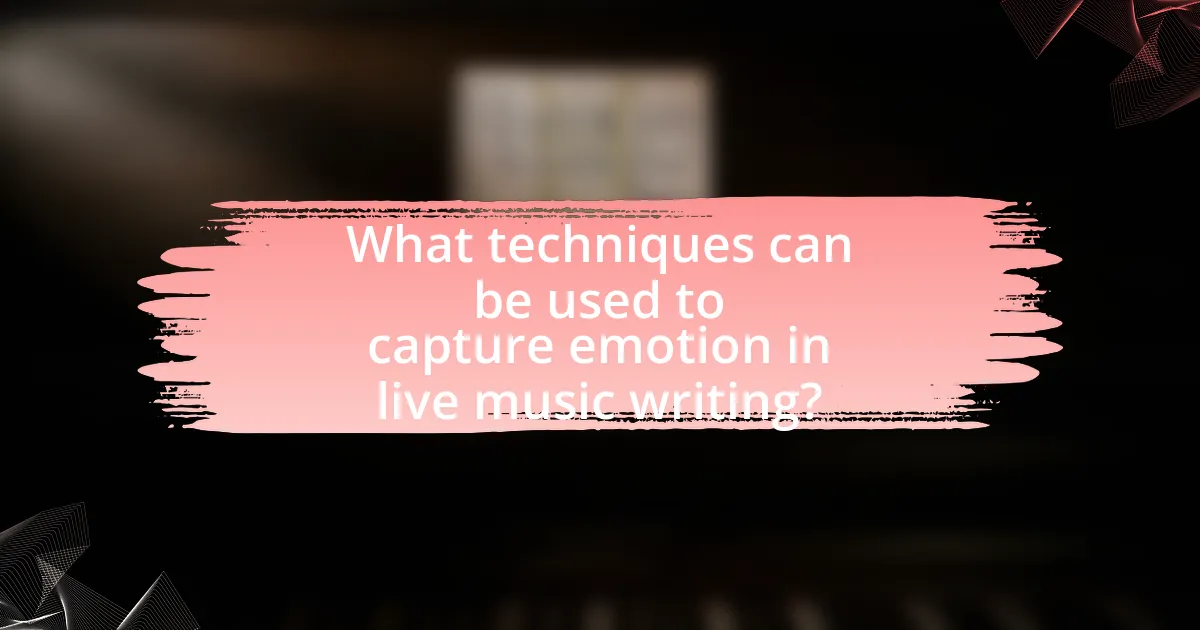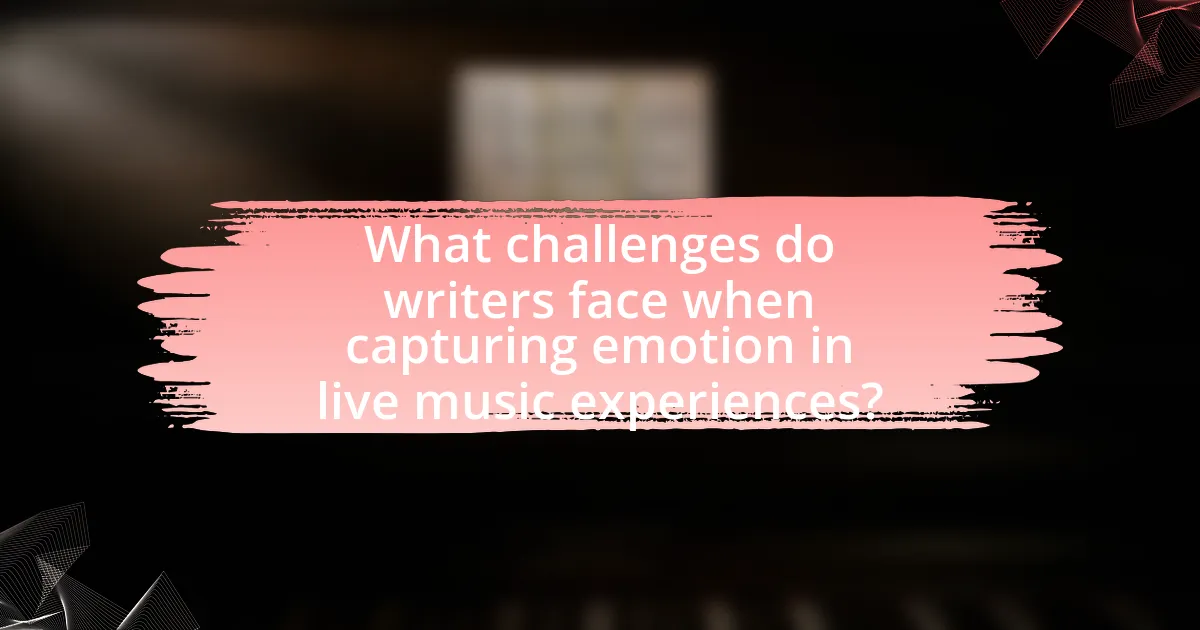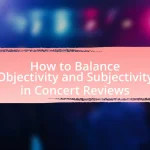The article “The Art of Capturing Emotion: Writing About Live Music Experiences” explores the techniques and significance of effectively conveying emotions in live music writing. It emphasizes the importance of vivid descriptions, sensory details, and personal reflections to create an immersive experience for readers. Key emotional elements such as connection, energy, and vulnerability are discussed, along with strategies for writers to identify and express these emotions. The article also addresses common challenges faced by writers, best practices for enhancing authenticity, and the role of storytelling in engaging audiences. Overall, it provides insights into how emotional writing can deepen the connection between music and its audience.

What is the Art of Capturing Emotion in Live Music Writing?
The art of capturing emotion in live music writing involves conveying the visceral experience of a performance through vivid descriptions and personal reflections. Effective live music writing engages the reader by illustrating the atmosphere, the artist’s energy, and the audience’s reactions, creating an immersive experience. For instance, using sensory details such as the sound quality, lighting, and crowd dynamics can evoke emotions that resonate with readers. Studies in music journalism highlight that writers who incorporate personal anecdotes and emotional responses can significantly enhance the relatability and impact of their narratives, making the experience feel authentic and immediate.
How does emotion influence the experience of live music?
Emotion significantly influences the experience of live music by enhancing audience engagement and connection to the performance. When individuals experience strong emotions, such as joy, sadness, or nostalgia, they are more likely to become immersed in the music, leading to a heightened sense of enjoyment and personal resonance with the performance. Research indicates that emotional responses to music can activate brain regions associated with pleasure and reward, such as the ventral striatum, which reinforces the positive experience of live performances. Additionally, studies show that live music can evoke collective emotions among audiences, fostering a sense of community and shared experience, which further amplifies the overall impact of the event.
What are the key emotional elements in live music performances?
The key emotional elements in live music performances include connection, energy, and vulnerability. Connection occurs between the performers and the audience, creating a shared experience that enhances emotional engagement. Energy is generated through the dynamics of the performance, influencing the audience’s mood and reactions. Vulnerability is expressed by artists through their music and stage presence, allowing audiences to relate to their emotions and experiences. Research indicates that these elements significantly impact audience satisfaction and emotional response, as evidenced by studies showing that live performances evoke stronger emotional reactions compared to recorded music.
How can writers identify and convey these emotions?
Writers can identify and convey emotions by closely observing the nuances of live music experiences, such as audience reactions, artist expressions, and the atmosphere of the venue. By paying attention to specific details like body language, facial expressions, and the energy in the room, writers can capture the emotional essence of the performance. For instance, a study by the Journal of Music Therapy indicates that emotional responses to music are often linked to physiological changes, which can be described in writing to enhance the emotional impact. Additionally, using descriptive language that evokes sensory experiences—such as the sound of the music, the visuals of the performance, and the feelings of the audience—allows writers to effectively convey the emotions associated with live music.
Why is writing about live music experiences important?
Writing about live music experiences is important because it captures the emotional and sensory aspects of the event, allowing readers to connect with the music on a deeper level. This form of writing not only preserves the fleeting moments of a live performance but also conveys the atmosphere, energy, and personal reactions that are unique to each experience. Research indicates that storytelling in music journalism enhances audience engagement, as it evokes memories and feelings associated with the music, making the experience more relatable and impactful. By documenting these experiences, writers contribute to the cultural narrative surrounding music, fostering appreciation and understanding among diverse audiences.
What role does storytelling play in music writing?
Storytelling plays a crucial role in music writing by enhancing emotional connection and engagement with the audience. Through narrative elements, songwriters can convey personal experiences, cultural contexts, and universal themes, making the music relatable and impactful. For instance, songs like “The River” by Bruce Springsteen illustrate storytelling by depicting the struggles of working-class life, which resonates deeply with listeners. This narrative approach not only captivates the audience but also fosters a shared emotional experience, reinforcing the power of music as a medium for storytelling.
How can writing about live music enhance audience engagement?
Writing about live music enhances audience engagement by creating a vivid emotional connection that resonates with readers. This connection is established through descriptive language that captures the atmosphere, energy, and personal experiences associated with live performances. For instance, studies show that emotionally charged narratives can increase audience retention and interest, as they evoke feelings that readers can relate to, making the experience more immersive. By detailing specific moments, such as the crowd’s reaction or the artist’s performance, writers can transport readers to the event, fostering a sense of presence and involvement that encourages deeper engagement with the music and the artist.

What techniques can be used to capture emotion in live music writing?
Techniques to capture emotion in live music writing include vivid imagery, sensory details, and personal anecdotes. Vivid imagery allows writers to paint a picture of the performance, enabling readers to visualize the scene and feel the atmosphere. Sensory details engage the audience by describing sounds, sights, and even smells associated with the event, creating an immersive experience. Personal anecdotes add authenticity and relatability, as they convey the writer’s emotional response to the performance, making the narrative more compelling. These techniques are effective because they evoke feelings and memories in readers, enhancing their connection to the music and the experience.
How can descriptive language enhance emotional impact?
Descriptive language enhances emotional impact by creating vivid imagery that resonates with the audience’s senses and emotions. When writers use specific adjectives, metaphors, and similes, they evoke feelings and memories, allowing readers to connect deeply with the experience being described. For instance, a description of a live music performance that includes details about the pulsating rhythm, the warmth of the crowd, and the electrifying atmosphere can transport readers to that moment, making them feel as if they are part of the experience. Research indicates that emotionally charged language can activate brain regions associated with emotion and memory, reinforcing the connection between the reader and the narrative.
What are effective adjectives and metaphors for describing music?
Effective adjectives for describing music include “melodic,” “rhythmic,” “haunting,” “uplifting,” and “soulful.” These adjectives convey specific qualities of music that evoke emotional responses. For instance, “melodic” suggests a pleasing arrangement of sounds, while “haunting” implies a lingering emotional impact.
Metaphors such as “a symphony of colors” or “a river of sound” effectively illustrate the experience of music. The metaphor “a symphony of colors” evokes the idea that music can paint vivid emotional landscapes, while “a river of sound” suggests a flowing, immersive experience. These descriptors enhance the listener’s understanding and emotional connection to the music.
How does imagery contribute to the emotional experience?
Imagery significantly enhances the emotional experience by creating vivid mental pictures that evoke feelings and sensations. When writers use descriptive language to paint scenes, they engage the reader’s senses, allowing them to connect emotionally with the content. For instance, studies show that imagery can activate the same brain regions involved in actual experiences, making emotions more palpable. This phenomenon is supported by research from the University of California, which found that imagery can trigger emotional responses similar to those experienced in real-life situations, thereby deepening the audience’s emotional engagement with the narrative.
What narrative structures work best for live music experiences?
The narrative structures that work best for live music experiences include chronological storytelling, thematic exploration, and immersive first-person perspectives. Chronological storytelling effectively captures the progression of a live performance, allowing audiences to experience the buildup and climax of the event, as seen in concert reviews that follow the setlist order. Thematic exploration focuses on specific emotions or concepts conveyed through the music, providing depth and resonance, as demonstrated in analyses that connect songs to broader cultural or personal themes. Immersive first-person perspectives engage readers by placing them in the moment, enhancing emotional connection, which is evident in personal narratives that describe sensory experiences during performances. These structures collectively enhance the storytelling of live music experiences by creating a vivid and relatable context for the audience.
How can a chronological approach affect emotional storytelling?
A chronological approach enhances emotional storytelling by creating a clear and logical progression of events that allows the audience to experience emotions in real-time. This method enables the audience to connect with characters and situations as they unfold, fostering a deeper emotional investment. For instance, in live music experiences, detailing the sequence of a performance—from the anticipation before the show to the climactic moments of the performance—can evoke feelings of excitement and nostalgia. Research indicates that narratives structured chronologically are more easily processed by audiences, leading to greater emotional engagement and retention of the story (Zhang, 2018, “The Impact of Narrative Structure on Emotional Engagement,” Journal of Communication).
What are the benefits of using flashbacks or thematic structures?
Using flashbacks or thematic structures enhances storytelling by deepening emotional engagement and providing context. Flashbacks allow writers to reveal crucial backstory, enriching character development and plot progression, which can evoke stronger emotional responses from the audience. Thematic structures create a cohesive narrative that resonates with readers, as they can identify recurring motifs that reflect universal experiences. For instance, in literature and film, the use of flashbacks has been shown to increase viewer investment in characters, as seen in works like “The Godfather Part II,” where past events illuminate present motivations. This technique not only adds layers to the narrative but also fosters a more immersive experience for the audience.

What challenges do writers face when capturing emotion in live music experiences?
Writers face significant challenges when capturing emotion in live music experiences, primarily due to the ephemeral nature of live performances. The intensity of emotions felt during a concert can be difficult to translate into words, as these feelings are often tied to the immediate atmosphere, audience reactions, and the unique energy of the moment. Additionally, writers must contend with the limitations of language, which may not fully encapsulate the visceral sensations and personal connections that arise during a live show.
Research indicates that emotional responses to music are highly subjective and can vary widely among individuals, complicating the task of conveying a universal experience. For instance, a study published in the journal “Psychology of Music” by Juslin and Västfjäll (2008) highlights how personal memories and cultural contexts influence emotional interpretation, making it challenging for writers to resonate with a diverse audience. Thus, the combination of fleeting moments, subjective experiences, and linguistic limitations creates a complex landscape for writers aiming to authentically capture the emotional essence of live music.
How can writers overcome writer’s block in music writing?
Writers can overcome writer’s block in music writing by employing techniques such as free writing, setting specific goals, and seeking inspiration from various sources. Free writing allows writers to express thoughts without self-censorship, which can stimulate creativity and lead to new ideas. Setting specific goals, such as writing a certain number of lyrics or melodies each day, creates a structured approach that can help maintain momentum. Additionally, seeking inspiration from different genres, attending live performances, or collaborating with other musicians can provide fresh perspectives and ideas, ultimately breaking the block. Research indicates that engaging in diverse creative activities can enhance overall creativity, supporting the effectiveness of these strategies.
What strategies can help in finding the right emotional angle?
To find the right emotional angle in writing about live music experiences, one effective strategy is to immerse oneself in the atmosphere of the event. Engaging fully with the music, audience reactions, and the venue’s ambiance allows for a deeper understanding of the emotional landscape. This approach is supported by research indicating that emotional engagement enhances narrative quality, as seen in studies on experiential writing. Additionally, utilizing sensory details—such as sounds, sights, and feelings—can evoke emotions in readers, making the experience relatable and vivid. By focusing on personal connections to the music and the shared experiences of the audience, writers can authentically convey the emotional essence of live performances.
How can feedback from peers improve emotional writing?
Feedback from peers can significantly enhance emotional writing by providing diverse perspectives that highlight strengths and weaknesses in the expression of feelings. When peers review emotional writing, they can identify areas where the writer’s intent may not be clear or where the emotional impact could be intensified. For instance, a study published in the Journal of Writing Research indicates that peer feedback fosters a collaborative environment that encourages writers to refine their emotional narratives, leading to more authentic and resonant expressions. This process not only improves the clarity of the emotional message but also helps writers connect more deeply with their audience, ultimately enriching the overall quality of the writing.
What common pitfalls should writers avoid?
Writers should avoid several common pitfalls when capturing emotion in live music experiences. One major pitfall is relying too heavily on clichés, which can dilute the authenticity of the writing. For instance, phrases like “the music took me to another world” are overused and fail to convey genuine emotion. Another pitfall is neglecting sensory details; effective writing should engage multiple senses to create a vivid picture for the reader. Additionally, writers often make the mistake of focusing too much on technical aspects of the performance rather than the emotional impact it has on the audience. This can lead to a disconnection between the reader and the experience being described. Lastly, failing to convey personal reflections can result in a lack of depth; sharing personal insights allows readers to connect on a more intimate level.
How can clichés dilute emotional impact in writing?
Clichés dilute emotional impact in writing by making expressions feel predictable and unoriginal. When writers rely on overused phrases, they fail to convey genuine feelings, leading to a lack of connection with the audience. Research indicates that unique and vivid language enhances emotional resonance, while clichés can create distance, as they do not evoke fresh imagery or personal experiences. For instance, phrases like “heart of gold” or “rollercoaster of emotions” have become so commonplace that they lose their power to evoke strong feelings, ultimately diminishing the reader’s engagement with the narrative.
What are the risks of over-exaggeration in emotional descriptions?
Over-exaggeration in emotional descriptions can lead to a loss of credibility and authenticity in writing. When emotions are described in an exaggerated manner, readers may perceive the content as insincere or manipulative, which can diminish their trust in the writer. Research indicates that authenticity is crucial in emotional storytelling; for instance, a study published in the Journal of Personality and Social Psychology found that audiences respond more positively to genuine emotional expressions compared to exaggerated ones. Additionally, over-exaggeration can alienate readers who may feel that the descriptions do not accurately reflect their own experiences, leading to disengagement from the narrative.
What are some best practices for writing about live music experiences?
Best practices for writing about live music experiences include immersing yourself in the atmosphere, capturing sensory details, and conveying emotional responses. Immersing oneself in the atmosphere allows the writer to authentically describe the energy of the performance, which is crucial for readers who were not present. Capturing sensory details, such as the sound quality, lighting, and crowd reactions, enhances the vividness of the narrative. Conveying emotional responses helps readers connect with the experience on a personal level, making the writing resonate more deeply. These practices are supported by the fact that effective music writing often relies on the ability to evoke feelings and create a sense of presence, as demonstrated in successful reviews and articles across various music publications.
How can writers effectively balance personal experience with audience relatability?
Writers can effectively balance personal experience with audience relatability by focusing on universal themes and emotions that resonate with a broad audience. By identifying common feelings such as joy, nostalgia, or excitement that arise from live music experiences, writers can frame their personal stories in a way that invites readers to connect with their own memories and feelings. For instance, a writer might describe a specific concert that evoked a sense of freedom, which many readers can relate to, even if their experiences differ. This approach not only personalizes the narrative but also ensures that it remains accessible and engaging to a wider audience.
What tips can enhance the authenticity of emotional writing?
To enhance the authenticity of emotional writing, writers should draw from personal experiences and genuine emotions. This approach allows for a deeper connection with the audience, as authentic emotions resonate more profoundly. For instance, using specific sensory details, such as the sound of a live performance or the atmosphere of a venue, can evoke vivid imagery and feelings in readers. Research indicates that emotional writing is more impactful when it includes relatable experiences, as demonstrated in studies on narrative transportation, which show that readers engage more deeply with stories that reflect real emotions and situations.


